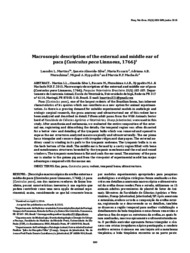Macroscopic description of the external and middle ear of paca (Cuniculus paca Linnaeus, 1766).
Macroscopic description of the external and middle ear of paca (Cuniculus paca Linnaeus, 1766).
Author(s): MARTINS, L. L.; ALMEIDA-SILVA, I.; ROSSATO, M.; MURASHIMA, A. A. B.; HYPPOLITO, M. A.; MACHADO, M. R. F.
Summary: Paca (Cuniculus paca), one of the largest rodents of the Brazilian fauna, has inherent haracteristics of its species which can conribute as a new option for animal experimantation. As there is a growing demand for suitable experimental models in audiologic and otologic surgical research, the gross anatomy and ultrastructural ear of this rodent have been analyzed and described in detail. Fifteen adult pacas from the Wild Animals Sector herd of Faculdade de Ciências Agrárias e Veterinárias, Unesp-Jaboticabal, were used in this study. After anesthesia and euthanasia, we evaluated the entire composition of the external ear, registering and ddescribing the details; the temporal region was often dissected for a better view and detailing of the tympanic bulla which was removed and opened to expose the ear structures analyzed mascroscopically and ultrastructurally. The ear pinna has a triangular and concave shape with irregular ridges and sharp apex. The external auditory canal is winding in its path to the tympanic mebrane. The tympanic bulla is is on the back-bottom of the skull. The middle ear is formed by a cavity region filled with bone and membranous structures bounded by the tympanic membrane and the oval and round windows. The tympanic membrane is flat and seals the ear canal. The anatomy of the paca ear is similar to the guinea pig and from the viewpoint of experimental model has major advantages compared with the mouse ear.
Publication year: 2015
Types of publication: Journal article
Keywords: Cuniculus paca, Ears, Orelha, Osso temporal, Paca, Rodents, Roedor, Temporal bone, Ultraestrutura, Ultrastructure
Observation
Some of Embrapa's publications are published as ePub files. To read them, use or download one of the following free software options to your computer or mobile device. Android: Google Play Books; IOS: iBooks; Windows and Linux: Calibre.
Access other publications
Access the Agricultural Research Database (BDPA) to consult Embrapa's full library collection and records.
Visit Embrapa Bookstore to purchase books and other publications sold by Embrapa.

